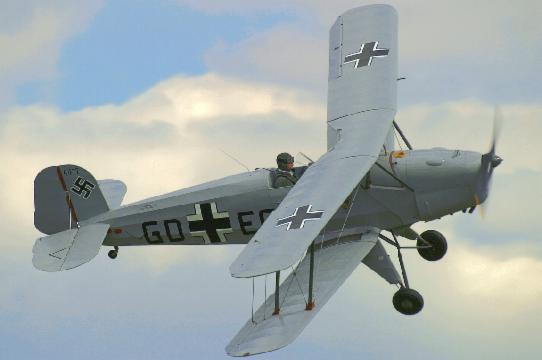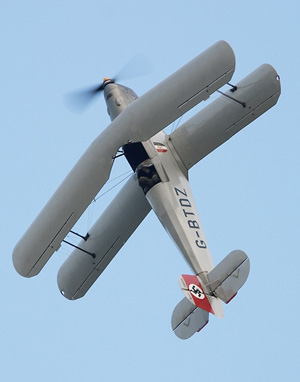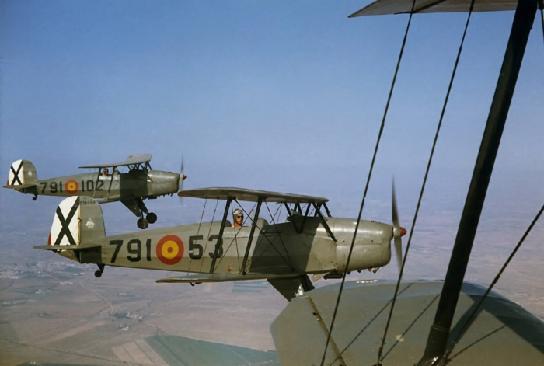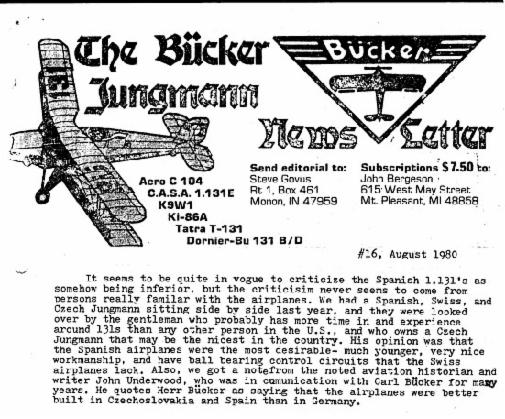The bird that taught the Third Reich to Fly
Bücker Bü 131 ‘Jungmann’
 |
By the beginning of the 1930s, Germany was starting to show its discontent with the Treaty of Versailles which did not permit either powered flight or military development.
Thousands of pilots had been trained in the Hitler Youth Glider Clubs, those that would become the top scoring pilots of all times, such as the highest scoring fighter pilot in history, Erich ‘Bubi’ Hartman. A powered airplane was needed for them to keep progressing. Here is where the story of the 'Jungmann' began:
Rather than working again for Heinkel, and foreseeing what was about to take place in Germany, Bücker decided to start his own company, ‘Bücker Flugzeugbau GmbH’ . Within six months of the requirements for a new powered trainer being issued, Anders Andersson had the prototype Bü 131A ‘Jungmann’, registered D-3150 and powered by a 80HP Hirth HM-60R, ready for its test flight. A light aerobatic biplane, with two seats in tandem, its construction incorporated the most innovative techniques. It was April the 27th 1934, and Joachim Von Köpen was at the stick.
The requirement was for a cheap to operate trainer airplane, hence the decision to initially install a 80HP engine. Its manufacture had to be easy, simple, cheap; the aircraft fast, light, strong... Bücker´s answer was the Bü 131 'Jungmann'.
 Photo Copyrighted to Colin K. Works
Photo Copyrighted to Colin K. Works A
really advanced, light and completely new design, docile and easy to fly for the new pilot,
the 'Jungmann' was also sturdy to tolerate his mistreatment, relatively simple to mass produce, thanks to details such
as interchangeable upper and lower wing with constant chord; yet aerobatic and
agile thanks to its four ailerons, with a 12G limit and responding to any
request from the pilot smoothly and effortlessly, being able to go through all the aerobatic maneuvers of the time. By the end of the year, the demands
of the DLV were so great that Bücker moved
his factory to Rangsdorf, on the outskirts of Berlin.
Out of its "secret" existence by 1936, the Luftwaffe adopted the airplane officially as its basic primary trainer. The Bü 131B was born with a more powerful engine, the 105 to 110HP Hirth HM-504, a decisive factor that increased its already excellent performances. That was also to be the export version. Appreciating its capabilities, orders were placed by different international governments whose orders were initially filled. Soon the orders began to eclipse the capabilities of the factory, so licenses were granted, first to Switzerland, then Czechoslovakia, Japan, Hungary and Spain.
 |
Among the main customers, we need to list Switzerland. They built 94 units under license in the Dornier factories y Altenrheim, on the Bondesee (Lake Constance). Many of those aircraft remained in service until 1971.
Czechoslovakia,
after also manufacturing a dozen airplanes (in the Tatra factory
and designated Tatra T-131), reconditioned another dozen after the war,
designated Aero C-4. Equipped with a 105HP Walter Minor III engine, it became the Aero
C-104 and was manufactured in quantity exceeding 250 up until 1950. During the German occupation, that same factory manufactured over 300 Bü-131B.
Japan, after evaluating the aircraft and purchasing 20 units, placed a requirement to local manufacturers: "We need an airplane as good as this one". Three projects were submitted, but none were as good as the 'Jungmann'. So Japan bought the manufacturing rights and manufactured 339 aircraft between 1942 and 1945 for the Imperial Navy in the Kiushu factory, denominated K9W1. The same airplane, under the denomination Ki-86, was manufactured for the Army by Kokusai in the amazing quantity of 1,037 units. All of these airplanes were powered by a 110HP Hitachi engine. The allied nicknamed the model as “Cypress”.
It´s interesting to note that, given the lack of strategic materials in Japan during the war, the Japanese tried making an all-wood 'Jungmann'. The idea didn´t work very well.
None of these almost 2,000 Japanese aircrafts exists today. Only one, a Ki-86a, survided the war, being sent to Britain for evaluation. It was stupidly burned during a fire suppresion exercise in R.A.F. Station Wroughton, in Wiltshire, in the mid 50s.
Among other overseas customers for the aircraft – 19 in total -, are listed Yugoslavia, with over 300 units, Hungary with over 100, Sweden, Bulgaria, Finland, Romania, Brazil and Chile.
Initially, 100 units were purchased directly from Bücker, then, after a manufacturing license was obtained, a further quantity of around 550. were produced by the Spanish company C.A.S.A. The E.A.E. is the only Air Force that has used every single active variant of the Bü 131 series: The Bü 131A, the Bü 131B, the Bü 131D and finally, the C.A.S.A. improved version from the 1950´s, the C.A.S.A. 1,131-E.
 |
The C.A.S.A. 1,131-E
was designed as an improved version of the Bü 131-D2, 200 units of which had
been manufactured previously by C.A.S.A. under license. Those improvements included:
- A reinforced airframe, allowing it to handle more powerful engines.
- Stronger tail and empennage, now with seven ribs on the rudder and a redesign to allow more abrupt landings.
- More streamlined cowling.
- An electrical system, to accommodate a starter and other electric equipment.
 |
These airplanes received an engine specifically designed for them: the ENMASA 'Tigre', in six different versions of 125 and 150HP, being the latest capable of inverted flight, with a starter and generator. All of the existing and older versions of the airplane were retrofitted to the C.A.S.A. 1,131-E.
Bücker himself praised the great work made by the Spanish manufactured ‘Jungmann’ and ‘Jungmeister’s. The historian John Underwood echoed his comments in the Bücker Newsletter.
 |
The 'Jungmann' was still at the top in the world´s Aerobatic Championships by the sixties. In 1962, Albert Reusch of Switzerland came 2nd in Coventry flying a 'Jungmann' modified to a Lycoming engine. His son, Hansreudi Reusch, ended 1st in the Swiss Championships of 1963 flying the same airplane, HB-UTH. Another 'Jungmann' (a 'Lerche'; single seater modification by Pilatus, equipped with a 180HP Lycoming), with Arnold Wagner at the controls, finished 8th in the World Championship in Bilbao, in 1964, beating the the Yak-18 and Zlins also competing there. Even in 1970 yet another 'Jungmann' participated and made a good showing in the hands of Eric Muller at the 6th FAI World Aerobatic Championships; a time when newer, powerful and specifically designed aerobatics airplanes - Zlins, Pitts, Mudry or Yakovlevs - were already well known in the circuit..
Unlike some contemporary aircraft, such as the D.H. Tiger Moth, or Stampe, the 'Jungmann' was not an evolution of an older design. It was conceived and designed from scratch. Designed from the outset to be a trainer and an aerobatic airplane, with well balanced, responsive controls, and viceless, predictable handling. It flies beautifully.
Being much lighter than most of the comparable airplanes, the 'Jungmann' is capable of much more than most of them as far as aerobatics are concerned, without losing short field capabilities. Those aerobatic capabilities are particularly noticeable in the roll. Four ailerons make it fast, easy and precise.
A Tiger Moth only has two ailerons, on the lower wings, a greater wing area and higher weight, complicating and slowing the maneuver, which typically ends sloppily, requiring much more effort on the stick. The 'Jungmann' also has exceptional inverted performance. Few other biplanes of the time fly as well upside down as it does, and It´s been said that it only takes a sneeze to flick roll (snap roll) a 'Jungmann'.
Despite its high wing loading, stalls are incredibly docile. The aircraft stalls gently, without any tendency to drop a wing. Spins require a little work on the controls to start, but the recovery is about as fast as you can think about it, often surprising the pilot with its fast response to the rudder.

Original text in Spanish by BUCKER-PRADO.
Many thanks to Stephen Beaver (www.bucker.info) for his help translating and 'de-Spaniarizing' the text!
- Manuel Luis Ramos García.
- Asgeir Westgaard.
- Chris Mattison.
Many thanks to all for your help.